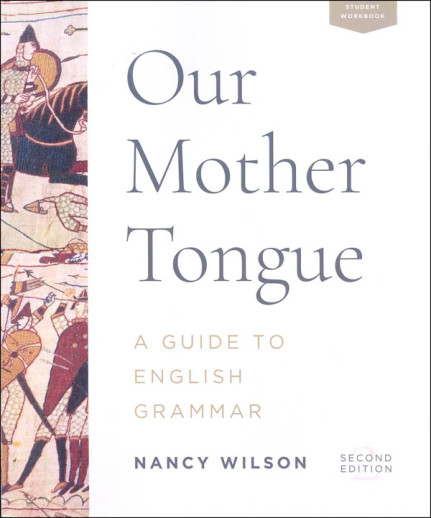We use cookies to make your experience better. To comply with the new e-Privacy directive, we need to ask for your consent to set the cookies. Learn more.
Our Mother Tongue: Guide to English Grammar 2nd Ed
Studying our language enables us to choose our words wisely, enjoy and appreciate great literature, understand the thoughts of others, give clear and correct expression to our own thoughts, and train our minds to think in an orderly fashion. Designed to give a comprehensive overview of all aspects of our language, Our Mother Tongue can be used as a review and reference tool for the instructor or for introducing an older student to a systematic examination of our language. Starting with the basic facts of grammar (the eight classes of words and the parts and types of sentences), author Nancy Wilson provides a thorough examination of all the major concepts in English by looking at the special properties of nouns, pronouns, verbs, verbals, and modifiers. There are examples, explanations and definitions followed by exercises. Many of the examples and exercise sentences are taken from Scripture and from great English writers. Adding spice to this examination are periodic sidebars detailing the development of the English language. Did you know that many of our grammar rules came into being in the eighteenth century when the Enlightenment inspired thinkers to reduce everything to neat, tidy, governable systems? Diagramming is definitely a part of this overview. Like all graphic organizers, the use of diagramming trains the student to quickly analyze the subject matter - in this case, sentence structure.
Changes in this 2nd edition (2019) include a new layout, daily schedules, a new section on the Oxford comma, fun grammar quotes and increased numbers of exercises. The Student Workbook provides instruction, examples, sidebar info, and several sets of exercises for each section.
In this English grammar guide, Nancy Wilson surveys the major concepts in English grammar for beginners at the late elementary and junior high level (recommendedgrades 6-9).
Wilson avoids common, contrived sentences that serve merely to illustrate her point; instead, she uses many selections from Scripture and from great English writers which help to instruct the student through their content, style, and structure. In addition to a helpful format that highlights key definitions, punctuation issues, and important concepts, short historical sidebars tell the fascinating story of the development of English. She continues the traditional and challenging exercise of sentence diagramming, which trains students to quickly analyze the structure of any given sentence. The grammatical explanations, the logic of diagrams, and the rhetoric of her examples blend with complementary emphases to create a helpful classical and Christian text.
Studying our language enables us to choose our words wisely, enjoy and appreciate great literature, understand the thoughts of others, give clear and correct expression to our own thoughts, and train our minds to think in an orderly fashion. Designed to give a comprehensive overview of all aspects of our language, Our Mother Tongue can be used as a review and reference tool for the instructor or for introducing an older student to a systematic examination of our language. Starting with the basic facts of grammar (the eight classes of words and the parts and types of sentences), author Nancy Wilson provides a thorough examination of all the major concepts in English by looking at the special properties of nouns, pronouns, verbs, verbals, and modifiers. There are examples, explanations and definitions followed by exercises. Many of the examples and exercise sentences are taken from Scripture and from great English writers. Adding spice to this examination are periodic sidebars detailing the development of the English language. Did you know that many of our grammar rules came into being in the eighteenth century when the Enlightenment inspired thinkers to reduce everything to neat, tidy, governable systems? Diagramming is definitely a part of this overview. Like all graphic organizers, the use of diagramming trains the student to quickly analyze the subject matter - in this case, sentence structure.
Changes in this 2nd edition (2019) include a new layout, daily schedules, a new section on the Oxford comma, fun grammar quotes and increased numbers of exercises. The Student Workbook provides instruction, examples, sidebar info, and several sets of exercises for each section. The Answer Key provides a daily lesson plan (for covering the book in a semester) plus the answers to most of the exercises (including diagrams). Answers to some exercises are more subjective; therefore, answers will vary and are not included in the key.
| Product Format: | Softcover Book |
|---|---|
| Grades: | 4-AD |
| Brand: | Canon Press |
| Author: | Nancy Wilson |
| ISBN: | 9781947644557 |
| Length in Inches: | 9.875 |
| Width in Inches: | 8.375 |
| Height in Inches: | 0.625 |
| Weight in Pounds: | 1.2 |
So far my 9th grader is enjoying this grammar program. Its well-written and easy to comprehend.


It is part of the Charlotte Mason curriculum we are using from amblesideonline
Looking for more information on grammar rules and etiquette for English class.
required for class
I chose this grammar book because it appears to teach solid grammar lessons, and I like that the Bible is used for text examples.